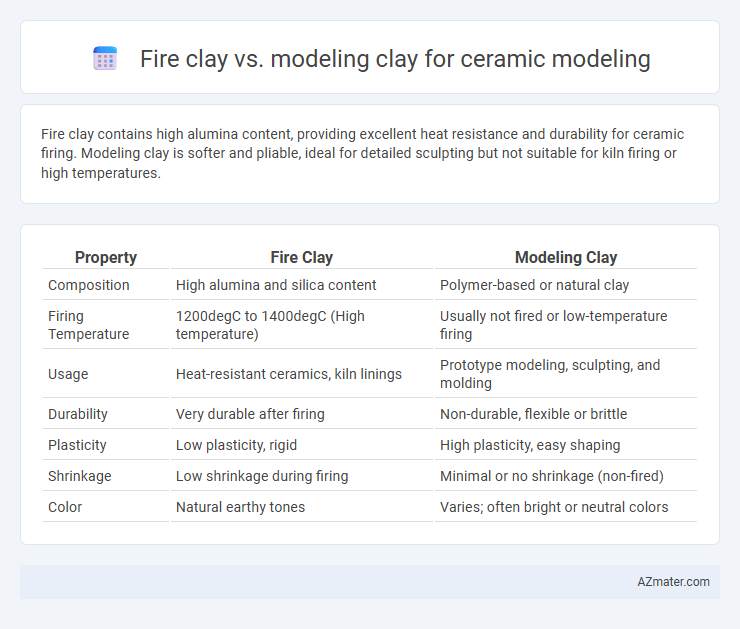Fire clay contains high alumina content, providing excellent heat resistance and durability for ceramic firing. Modeling clay is softer and pliable, ideal for detailed sculpting but not suitable for kiln firing or high temperatures.
Table of Comparison
| Property | Fire Clay | Modeling Clay |
|---|---|---|
| Composition | High alumina and silica content | Polymer-based or natural clay |
| Firing Temperature | 1200degC to 1400degC (High temperature) | Usually not fired or low-temperature firing |
| Usage | Heat-resistant ceramics, kiln linings | Prototype modeling, sculpting, and molding |
| Durability | Very durable after firing | Non-durable, flexible or brittle |
| Plasticity | Low plasticity, rigid | High plasticity, easy shaping |
| Shrinkage | Low shrinkage during firing | Minimal or no shrinkage (non-fired) |
| Color | Natural earthy tones | Varies; often bright or neutral colors |
Introduction to Fire Clay and Modeling Clay
Fire clay is a refractory material known for its high heat resistance and durability, commonly used in ceramic modeling for creating kiln bricks and heat-resistant pottery. Modeling clay, often composed of non-refractory, pliable materials like polymer or water-based compounds, is favored for detailed sculpting and prototyping but lacks the heat tolerance of fire clay. Both clays serve distinct purposes in ceramics, with fire clay suited for functional, high-temperature applications and modeling clay ideal for artistic shaping and design.
Key Differences Between Fire Clay and Modeling Clay
Fire clay is a high-temperature resistant material composed primarily of kaolinite, used in ceramic modeling for its durability and ability to withstand firing temperatures above 1,100degC. Modeling clay, often made from non-refractory materials like oil-based or polymer compounds, is primarily used for sculpting and shaping models without the intention of firing in a kiln. The key differences lie in fire clay's heat resistance and suitability for kiln-firing, while modeling clay remains pliable and non-ceramic, making it unsuitable for permanent ceramic creations.
Composition and Raw Materials
Fire clay consists primarily of alumina and silica minerals, derived from naturally occurring clays that can withstand high kiln temperatures without deforming. Modeling clay typically contains softer, more plastic raw materials such as kaolin, ball clay, and various organic binders, designed for easy shaping but not necessarily for firing. The high refractory nature of fire clay makes it ideal for ceramic molds and kiln linings, while modeling clay excels in detailed sculpting and prototyping before firing.
Firing Temperatures and Heat Resistance
Fire clay exhibits exceptional heat resistance with firing temperatures typically ranging from 1,200degC to 1,400degC, making it ideal for ceramics subjected to high-temperature kiln firings. Modeling clay, often formulated for sculpting and air-drying, usually cannot withstand firing temperatures above 1,000degC and may deform or crack when exposed to intense heat. The superior refractory properties of fire clay enable it to maintain structural integrity and resist thermal shock during ceramic firing processes.
Workability and Texture
Fire clay offers a stiffer, more heat-resistant texture ideal for sculpting durable ceramic pieces, exhibiting limited flexibility but excellent shape retention during firing. Modeling clay provides a softer, more malleable consistency that enhances detailed work and ease of manipulation but may lack the thermal stability required for kiln firing. Artists often prefer fire clay for structural forms and modeling clay for intricate, fine-textured designs.
Applications in Ceramic Modeling
Fire clay offers high heat resistance and durability, making it ideal for sculpting ceramic pieces intended for kiln firing and functional pottery. Modeling clay, typically non-fired and pliable, suits preliminary design work, prototypes, and detailed sculptural studies but lacks the structural integrity for final ceramic applications. Artists often combine modeling clay for initial forms with fire clay for creating finished, heat-resistant ceramic artworks.
Durability and Final Strength Comparison
Fire clay exhibits superior durability and final strength compared to modeling clay due to its high refractory properties and ability to withstand intense kiln temperatures without cracking. The dense composition of fire clay enhances structural integrity in ceramic modeling, making it ideal for functional pottery and sculptural works requiring long-term resilience. Modeling clay, while easier to shape, lacks the same thermal endurance and rigidity after firing, resulting in weaker final ceramic pieces prone to breakage.
Cost and Availability
Fire clay is generally more expensive and less readily available than modeling clay due to its refractory properties and use in high-temperature ceramic applications. Modeling clay is widely accessible at craft stores and online, available at a lower price point, making it ideal for beginners and casual ceramic artists. While fire clay offers superior heat resistance, its cost and limited availability can be prohibitive for everyday modeling purposes.
Best Uses for Fire Clay vs Modeling Clay
Fire clay is best suited for projects requiring high heat resistance and durability, such as kiln-fired ceramics, pottery, and sculptures exposed to thermal stress. Modeling clay, typically non-firing and pliable at room temperature, is ideal for creating detailed prototypes, practice models, and temporary forms without the need for kiln firing. Fire clay's composition allows it to withstand extreme temperatures without cracking, making it the preferred choice for functional ceramic ware, whereas modeling clay excels in ease of shaping and reusability for artistic design.
Choosing the Right Clay for Your Ceramic Project
Fire clay offers superior heat resistance and durability, making it ideal for functional ceramic pieces subjected to high temperatures such as cookware or kiln furniture. Modeling clay, often softer and more pliable, excels in detailed sculpting and prototyping but lacks the thermal stability required for firing. Selecting the right ceramic clay depends on the project's purpose: fire clay suits utilitarian ceramics needing strength and heat endurance, while modeling clay is best for artistic designs and non-functional models.

Infographic: Fire clay vs Modeling clay for Ceramic modeling
 azmater.com
azmater.com